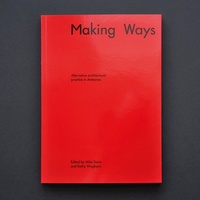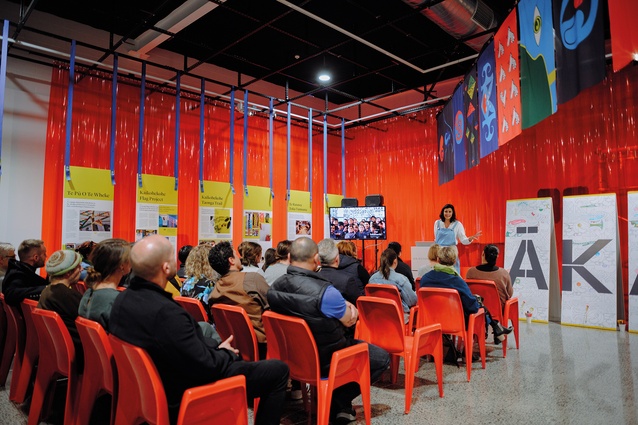Review: Making Ways: Alternative Architectural Practice in Aotearoa
Co-edited by Mike Davis (University of Auckland) and Kathy Waghorn (AUT), Making Ways: Alternative Architectural Practice in Aotearoa is a bright, new publication that seeks to conceptualise architectural work. Published by Objectspace, the book is, in one respect, a record of the Making Ways exhibition the gallery hosted in September and October 2019. But, in another, it represents the hope for a continuation of conversations the show started.
Making Ways – the exhibition – involved a four-week series of installations, lectures and workshops focusing on the ways-of-work of four boutique practices – Makers of Architecture, Hatch Workshop, unit Y and ĀKAU.

As a record, Making Ways – the book – opens with an essay by visiting academic Kester Rattenbury from the University of Westminster. Rattenbury was invited to Auckland to immerse herself in the exhibition and lecture on what she’d seen. Her essay offers a succinct biography of each practice and gives an overview of its exhibition.
Following the essay are edited transcripts of interviews held with each of the practices and these are set alongside photographs of the installations.
The transcripts lend Making Ways a personal tone and capture the unpretentious nature of the subject. Our work and how we do it are not things of high rhetoric but, instead, raise a common concern and a question of the common good. This common sensibility is evident in the informality of the interviews, which reveal how each of these youthful (or youthful-at-heart) practices is working out its place in the world. There is often an innocent surety to their motivations – typically, a mix of social, cultural, technological and environmental activism. But there’s also uncertainty about where to from here. Time and again, that uncertainty turns around the economic function of work.
Having shaped practices that foster dignified and socially fulfilling work, the architects are confronting the question of how to earn decent pay whilst doing what seems right and good. There’s a common acceptance that achievements to date have been on the backs of economic sacrifices that are unpalatable in the long term, or are supported by financial grants with limited lives, or are sustained by day jobs (i.e. in academia) that offset costs.
Making Ways also raises questions about what exactly constitutes an alternative practice. The exhibition gave four examples and let us search for the ties that bind. But the book has given curator and editor Kathy Waghorn the time and space to reflect on what was meant by the idea of an ‘alternative’, to consider more generally what characterises these ‘new forms of practice’ and to propose reasons for the importance of such alternatives.
One challenge Waghorn faces is how to deal with the parallel need, or inevitability, of defining the other. Making Ways celebrates practices ‘on the edge’ and people working in ‘expanded fields’. But what does it make of ‘normative architectural practice’?
If the edge is honoured, what of the centre? Is it derided as the ossification of tradition, convention and conformity? Whether intentionally or not, is it denigrated? And is this fair? This is particularly relevant given the centre seems to provide more readily for a core function of work that eludes those at the edge: a decent wage. And with a decent wage, one can raise a family, help build a community and make a home. These are all core functions of work that, in turn, contribute to a sense of esteem and all-important social recognition. So, the centre may have something going for it or, at least, it might if architects can earn a decent wage and work in a dignified way. Whether or not they do is something Peggy Deamer questions in her studies of architecture and labour.
The relationship between edges and centres needs to be negotiated by this inquiry into architectural work. Waghorn and Davis admit they came to Making Ways with a bias for an expanded and diverse future brought about through structural change rather than through the manipulation of existing systems. They’re attracted to the edges. They’re interested in architectural work offering resistance to a capitalist, political economy.
Alongside its capitalised economic function, architectural work fulfils a social function. It is a way to cultivate and exercise our abilities to produce something that society (hopefully) values. The experience of contributing to society and feeling the esteem of fellow citizens is vital to human flourishing.
This social idea precedes the profession’s capitalist monetisation. Architectural work traces a complicated line through the different political and financial models that have shaped history. Today’s architectural work, including that of the ‘alternative practices’, must be considered as part of this history.
Waghorn and Davis acknowledge this by concluding Making Ways with an essay entitled ‘Looking Backwards to Look Forwards’. Here, the pair presents their historical research into local models of alternative practice. They outline their methods and the selection criteria for deciding what is ‘alternative’, and then give brief biographies of eight architectural practices that fit the bill.
The biographies – of practices old and new – point to the potential of this project and raise awareness of how little we talk about our work in terms of labour. Ask an architect about their ‘work’ and they’ll invariably describe a building rather than what they did to help make it.
Waghorn and Davis’ research is beginning to historicise the labour side of architecture. But the pair reports that, post the 1980s, the published material about architectural practices stops questioning ethics, politics and the common good, and, instead, focuses almost entirely on the business of building. This paucity of material about practice presents a challenge, but the struggle they describe recalls Deamer’s diagnosis that architects suffer ‘work aphasia’. We seem incapable of speaking about what we do as work/labour.
This may prove to be one of those cases where the absence of research material is as revealing as the material itself. Nonetheless, the editors suggest they won’t be deterred by the difficulties and say their work hasonly just begun. The promise that more is to come renders Making Ways an exciting piece of work.











